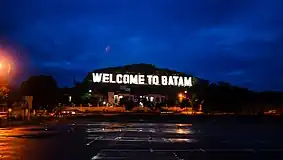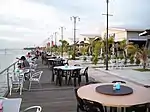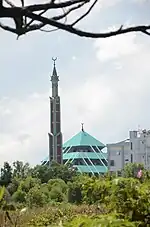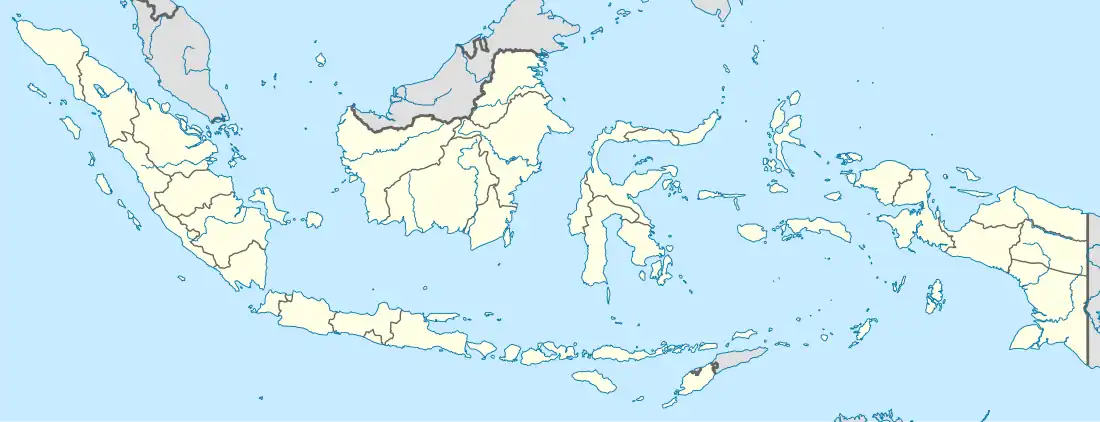Batam
Batam is the largest city in the province of Riau Islands, Indonesia. The city administrative area covers three main islands of Batam, Rempang, and Galang (collectively called Barelang), as well as Bulang to the west and several small islands. Batam Island is the core urban and industrial zone, while both Rempang Island and Galang Island maintain their rural character and low-density population; they are connected to Batam Island by short bridges. Bulang Island and the islands to its north forming Belakang Padang District lie to the west of Batam Island but are also administratively within the city. Batam is an industrial boomtown, an emerging transport hub, and part of a free trade zone in the Indonesia–Malaysia–Singapore Growth Triangle, located 20 km (12 mi) off Singapore's south coast and also part of the Indonesia–Malaysia–Thailand Growth Triangle.[2][3][4]
Batam | |
|---|---|
| City of Batam Kota Batam | |
| Regional transcription(s) | |
| • Jawi | باتام |
| • Chinese | 巴淡 |
From top left to right: Welcome to Batam signboard, Harbour Bay, Barelang Bridge, Nagoya Hill shopping mall, Batam Great Mosque, Sekupang Ferry terminal, Downtown Batam skyline at night and aerial view of Batam | |
 Coat of arms | |
| Nickname(s): Kota Industri ("The Industrial City") | |
 Location within Riau Islands | |
| Coordinates: 1°05′N 104°02′E | |
| Country | |
| Province | |
| Government | |
| • Mayor | Muhammad Rudi |
| • Vice mayor | Amsakar Achmad |
| Area | |
| • Total | 1,915 km2 (739 sq mi) |
| • Land | 1,034.73 km2 (399.51 sq mi) |
| • Water | 880 km2 (340 sq mi) |
| Population (mid 2022 estimate[1]) | |
| • Total | 1,269,820 |
| • Density | 660/km2 (1,700/sq mi) |
| Time zone | UTC+7 (Indonesia Western Time) |
| Postal code | 29453 |
| Area code | (+62) 778 |
| Vehicle registration | BP |
| Website | batamkota |
According to Statistics Indonesia's 2020 census, Batam had a municipal population of 1,196,396,[5] making it the third largest city in the region of Sumatra, after Medan and Palembang.[6] The official estimate as at mid 2022 was 1,269,413.[1] It is the closest part of Indonesia to Singapore, at a minimum land distance of 5.8 km. During the 2010 national census, Batam was the fastest-growing municipality in Indonesia the decade prior, with a population growth rate of 11% per year.[7] In 2017, the island suffered severe job losses; some 300,000 workers were laid off.[8]
History

The first recorded inhabitants at Batam Island are Malays known as Orang Laut, from the year 231 AD.[9] The island that once served as the field of struggle of Admiral Hang Nadim against the invaders was used by the government in the 1960s as a petroleum logistics base on Sambu Island.
In the 1970s, according to Presidential Decree number 41 year 1973, Batam Island was designated as a working environment of an industrial area supported by Batam Island Industrial Development Authority or better known as Batam Authority Board (BOB, now Batam Development Board (Indonesian: Badan Pengusahan Batam or BP Batam) as the driving force for the development of Batam, with the initial aim of making Batam the "Indonesian version of Singapore". With the rapid development of the island, based on Government Regulation No. 34 of 1983, the Batam District (which is part of Riau Islands Regency) was upgraded to municipality status which has the duties in running government administration and society and support the development of BP Batam.
In the Reformation era in the late 1990s, with Act No. 53 of 1999, the Batam administrative municipality changed its status to an autonomous region, namely Batam City Government to carry out governmental and developmental functions by involving BP Batam.
Geography
Batam is a roughly oval island with many bays, islets, and peninsulas, located west of Bintan Island, south of Singapore, north of Rempang and Galang, and east of Bulang Island. The Singapore Strait separates Singapore and Batam, while the Riau Strait separates Batam and Bintan. Batam Municipality covers 3,869km2, of which 1,034.73km2 is land, a figure which includes some land reclamation. However, Barelang Island (not actually one but three, see above) covers roughly 715km2 of that 1,034.73km2, and Batam island itself covers only about 410km2 out of the total. The bulk of the municipal population resides on Batam Island.
Climate
Batam has a tropical rainforest climate (Af) with heavy rainfall year-round.
| Climate data for Batam | |||||||||||||
|---|---|---|---|---|---|---|---|---|---|---|---|---|---|
| Month | Jan | Feb | Mar | Apr | May | Jun | Jul | Aug | Sep | Oct | Nov | Dec | Year |
| Average high °C (°F) | 29.8 (85.6) |
30.4 (86.7) |
31.0 (87.8) |
31.2 (88.2) |
31.2 (88.2) |
31.0 (87.8) |
30.7 (87.3) |
30.6 (87.1) |
30.6 (87.1) |
30.8 (87.4) |
30.3 (86.5) |
29.6 (85.3) |
30.6 (87.1) |
| Daily mean °C (°F) | 26.0 (78.8) |
26.3 (79.3) |
26.8 (80.2) |
27.0 (80.6) |
27.2 (81.0) |
27.1 (80.8) |
26.9 (80.4) |
26.8 (80.2) |
26.7 (80.1) |
26.8 (80.2) |
26.4 (79.5) |
25.9 (78.6) |
26.7 (80.0) |
| Average low °C (°F) | 22.2 (72.0) |
22.3 (72.1) |
22.6 (72.7) |
22.9 (73.2) |
23.3 (73.9) |
23.3 (73.9) |
23.1 (73.6) |
23.0 (73.4) |
22.9 (73.2) |
22.8 (73.0) |
22.6 (72.7) |
22.3 (72.1) |
22.8 (73.0) |
| Average rainfall mm (inches) | 261 (10.3) |
151 (5.9) |
186 (7.3) |
202 (8.0) |
191 (7.5) |
171 (6.7) |
173 (6.8) |
171 (6.7) |
190 (7.5) |
207 (8.1) |
275 (10.8) |
298 (11.7) |
2,476 (97.3) |
| Source: Climate-Data.org[10] | |||||||||||||
Governance

Mayor
The Batam city government takes care of all population administration and civil registration as well as human resources. The current mayor is Muhammad Rudi who has served since 2016, accompanied by Amsakar Ahmad as deputy mayor.[11]
Batam Development Board (BP)
The Agency for Free Trade Zone and Free Port of Batam, often abbreviated as BP Batam, is a government nonstructural body under the Chairmanship of the Board of Regions (DK) Batam Central Government, which is chaired by a Coordinating Minister for Economic Affairs. BP Batam plays a role in land governance and investment in the Special Economic Zone (SEZ) of Batam.
Administrative divisions

.jpg.webp)
Batam city is divided into twelve districts (kecamatan) – which include several adjacent islands such as Bulang to the west, and Rempang and Galang to the south, as well as Batam Island itself. Batam Island is connected by bridges to Rempang and Galang, and this group is thus often known by the abbreviation of Barelang. The districts are tabulated below with their areas, 2010 census populations[12] and 2020 census populations,[5] together with the official estimates as at mid 2022 [1] The table also includes the number of administrative villages within each district, all classed as urban kelurahan,[1] and its postal codes.
| Name of District (kecamatan) | Area in km2 | Pop'n Census 2010 | Pop'n Census 2020 | Pop'n estimate mid 2022 | No. of villages | Postal codes |
|---|---|---|---|---|---|---|
| Belakang Padang1 | 68.1 | 18,508 | 22,439 | 22,975 | 6 | 29412, 29413 29414, 29416 |
| Bulang2 | 158.8 | 9,531 | 10,707 | 11,079 | 6 | 29471 - 29476 |
| Galang3 | 350.9 | 14,983 | 16,989 | 17,611 | 8 | 29481 - 29487 |
| Sei Beduk (Sungai Beduk) | 106.0 | 80,349 | 96,193 | 100,768 | 4 | 29433 & 29437 |
| Sagulung | 55.3 | 149,727 | 209,306 | 226,040 | 6 | 29439 |
| Nongsa4 | 114.7 | 49,828 | 81,451 | 90,626 | 4 | 29465 - 29468 |
| Batam Kota (central city) | 38.9 | 162,238 | 198,617 | 208,965 | 6 | 29431 - 29433, 29461, 29464 |
| Sekupang5 | 68.9 | 100,108 | 156,283 | 172,347 | 7 | 29425 - 29428 |
| Batu Aji | 40.8 | 127,455 | 139,512 | 143,625 | 4 | 29422, 29424 & 29438 |
| Lubuk Baja | 11.2 | 80,780 | 84,533 | 86,277 | 5 | 29432, 29441,
29443 - 29445 |
| Batu Ampar | 11.2 | 58,745 | 60,450 | 61,497 | 4 | 29452 - 29454 |
| Bengkong | 14.0 | 92,033 | 119,836 | 127,593 | 4 | 29432 & 29458 |
Notes:
- 1 comprises 116 islands to the west of Batam Island.
- 2 comprises 70 islands to the southwest of Batam Island
- 3 comprises 82 islands to the south of Batam Island, including Galang Island and Rempang Island.
- 4 comprises the east part of Batam Island, but also includes 23 islands off the eastern shore.
- 5 includes 14 islands off the coast of Batam Island.
Demographics
At the 2020 census, Batam had a population of 1,196,396 inhabitants. The population was increasing rapidly, with a population growth rate of more than 8% per year between 2001 and 2012, but the increase has subsequently slowed.
| Year | Pop. | ±% |
|---|---|---|
| 1971 | 6,000 | — |
| 1978 | 34,000 | +466.7% |
| 1988 | 88,000 | +158.8% |
| 1992 | 123,000 | +39.8% |
| 1998 | 294,000 | +139.0% |
| 2005 | 616,088 | +109.6% |
| 2010 | 944,285 | +53.3% |
| 2020 | 1,196,396 | +26.7% |
| 2022 | 1,269,413 | +6.1% |
| sources:[13][14] | ||
Ethnicity
| Ethnic groups in Batam, 2000[15] | |
|---|---|
| Ethnicity | Percentage |
| Malay | 26.78% |
| Javanese | 17.61% |
| Batak | 14.97% |
| Minangkabau | 14.93% |
| Chinese | 6.28% |
| Buginese | 2.29% |
| Banjarese | 0.67% |
| Others | 16.47% |
Today, Batam is inhabited by a heterogeneous mixture of people due to labor migration and desire to be close to Singapore; it is very diverse, two-thirds of the population are migrants.[13] The predominant ethnicities are Malays, Javanese, Batak, Minangkabau, and Chinese. As a municipality it exemplifies the national motto of "Bhinneka Tunggal Ika" (Unity in Diversity). The location of Batam, which is close to Singapore, is conducive to the development of economic, sociopolitical, and cultural aspects of the local community.
Religion
Islam is the majority religion in Batam, followed by Christians, Buddhists and Hindus. Most of those who follow Islam are Javanese, Malays and Minangkabaus. The Great Mosque of Batam, located in the city center adjacent to the main square, the mayor's office and the provincial Parliament, is an important symbol of Islamic religious life in Batam. Christianity is also widely embraced by people of Batam, especially those from the Batak people of Sumatra and migrants from Flores also from East Indonesia. The majority of the Chinese population practises Buddhism. A number of Viharas are located in Batam, of which Vihara Duta Maitreya is one of the most frequented, and is the largest Vihara in Southeast Asia with an area of 4.5 hectares.
Language
Indonesian is the common lingua franca of Batam in daily use. Other languages such as local Malay (similar to the Malaysian standard as spoken in neighbouring Malaysia and Singapore), Minangkabau, Batak, Javanese, and Chinese ethnic dialects like Hokkien and Teochew are also used. The usage of Mandarin and English are trending due to Singaporean influence, especially by expatriates living in Batam.
Economy
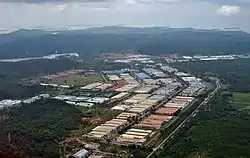
Based on Presidential Decree No. 41/1973, the Batam Industrial Development Authority (BP Batam) was established to manage 415 square kilometers of industrial complex in Batam City for heavy industry. Previously only Pertamina, the Indonesian state oil company, settled there with only 6,000 inhabitants.[17] Shipbuilding and electronics manufacturing are important industries on the island. Being located close to the ports of Singapore, the speed of goods shipping and product distribution is increased, benefiting the island's economy. With lower labor costs and special government incentives, it is the site of many factories operated by foreign companies.[18]
.jpg.webp)
Under a framework signed in June 2006, Batam, along with parts of neighbouring Bintan and Karimun, are a part of a Special Economic Zone with Singapore; this zone eliminates tariffs and value-added taxes for goods shipped between Batam and Singapore.[19] In 2007, Law No. 44 was enacted to supplement Law No. 36/2000 in establishing Batam as a free trade zone for 70 years. BP Batam still manages the industrial complex. And in 2016, the responsibility of industrial complex changed from the governor of Riau Islands Province to the Office of the Coordinating Economic Minister as per Presidential Decree No. 8/2016.[17]
Over 1.5 million tourists visited the city in 2015.[20] Batam is the third-busiest entry port to Indonesia next to Bali and Jakarta.[21] In 2014, around 58.8% of foreign tourists came from Singapore, 12.8% from Malaysia and 4.2% from South Korea.[22][23]
Transport
Ferry


Ferries connect Batam to Singapore, Bintan, and Johor Bahru (Malaysia). Five ferry terminals are on the island: Batam Harbour Bay Ferry Terminal, Nongsapura Ferry Terminal, Sekupang, Waterfront City, and Batam Center Ferry Terminal. Connections to Singapore are by way of Harbourfront and Tanah Merah Ferry Terminals run by Singapore Cruise Centre (SCC).
The most recent incident happened on 29 November 2015 when a ferry, 'Sea Prince', hit floating object(s) while en route to Singapore from Batam and began leaking. A total of 97 passengers were rescued on life rafts.[24][25]


Signs showing a picture of a raised finger over a pair of lips have been placed in August 2014 at the Batam Centre International Ferry Terminal to request silence while queuing for immigration to hear names being called and clearly hear instructions given by the immigration officer. Some visitors have been sent back immediately on the first ferry available for flouting this rule. The signs are also applicable at other terminals, but are not strictly enforced.[26]
Trans Batam


Trans Batam is the most reliable and the cheapest public transportation in Batam. It began to operate in 2005. Trans Batam is the second BRT system in Indonesia, after Jakarta's TransJakarta. The price for one ride is Rp2,000 for students and Rp4,000 for the public. Trans Batam operates from 05:30 to 19:00.
Trans Batam serves eight corridors of route:
| Corridor # | Origin & destination |
|---|---|
| 1 | Sekupang–Batam Centre |
| 2 | Tanjung Uncang–Batam Centre |
| 3 | Sekupang–Jodoh |
| 4 | Sagulung–Sekupang |
| 5 | Jodoh–Batam Centre |
| 6 | Tanjung Piayu–Batam Centre |
| 7 | Nongsa–Batam Centre |
| 8 | Punggur–Jodoh |
| Source: Batam City Government Transportation Agency[27] | |
Taxi

Taxis in Batam are available almost anywhere, at ferry terminals, the airport, shopping malls, hotels, etc. More than 3000 taxis are in Batam. In the early 2000s, Batam commonly had Toyota Corolla taxis. Starting in late 2013, more than 95% of taxis are brand new using the Toyota Limo and Chevrolet Lova.
Airport
Hang Nadim International Airport is the island's main airport, and has the longest runway of all airports in Indonesia. The airport was the largest airport in the Sumatra region from 1995 to 2012 with a capacity of six million passengers annually, and is now the second-largest in the Sumatra region after Kuala Namu International Airport in Medan, which has a capacity of eight million passengers. The airport has 4 paired jetbridges and 2 single jetbridges. Hang Nadim International Airport is a hub for Lion Air, Batik Air and Citilink. BP Batam, which operates Hang Nadim International Airport, will build a new terminal with a capacity of eight million passengers per year for each terminal (16 million passengers per year in total for two terminals) in late 2016. BP Batam intends to build eight paired jetbridges in the new terminal.[28] Domestic destinations include Pekanbaru, Palembang, Medan, Jakarta, Padang, Surabaya, Bandung, Bandar Lampung, Balikpapan, Yogyakarta, Makassar, and many more. International flights currently include Kuala Lumpur, Malaysia (operated by Batik Air Malaysia).
Environment
Due to piling works for touristic activity, sand mining, and logging for charcoal business, only 4.2% of Batam Island is covered in mangrove forests, a great decrease from 24% in 1970.[29] Originally, Batam Island had 41,500 hectares of mangrove forests.[30]
Gallery
 Turi Beach Resort
Turi Beach Resort The 2014 National MTQ Building in Dataran Engku Putri, Batam Centre
The 2014 National MTQ Building in Dataran Engku Putri, Batam Centre Great Mosque of Batam
Great Mosque of Batam Pacific Palace Hotel
Pacific Palace Hotel Batam Centre
Batam Centre Barelang Bridge
Barelang Bridge BCC Hotel Tower and iHotel Baloi
BCC Hotel Tower and iHotel Baloi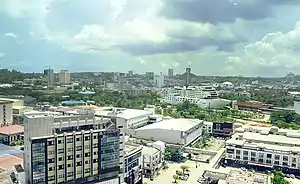 Batam Harbour Bay downtown, Harbour Bay ferry terminal
Batam Harbour Bay downtown, Harbour Bay ferry terminal
See also
References
- Badan Pusat Statistik, Jakarta, 2023, Kota Batam Dalam Angka 2023 (Katalog-BPS 1102001.2171)
- Richardson, Michael (3 August 1991). "In Today's Booming Asia, Business Knows No Boundaries". The New York Times. Retrieved 22 October 2020.
- "Indonesia-Malaysia-Thailand Growth Triangle (IMT-GT)". imtgt.org.
- "Country Information – Indonesia-Malaysia-Thailand Growth Triangle (IMT-GT)". imtgt.org.
- Badan Pusat Statistik, Jakarta, 2021.
- "Kota Batam Dalam Angka 2019". www.batamkota.bps.go.id. Retrieved 4 February 2020.
- Firman, Tommy (12 May 2012). "Urbanization and urban development patterns". The Jarkata Post. Retrieved 11 August 2016.
- Post, The Jakarta. "Batam economy in a state of emergency, mayor says". thejakartapost.com.
- "Pulau Batam Dihuni Orang Selat Sejak 231 Masehi". Tribun Batam (in Indonesian). 18 December 2012. Retrieved 18 December 2018.
- "Climate: Batam". Climate-Data.org. Retrieved 12 November 2020.
- "Dari Demokrat Rudi Loncat ke Nasdem". Batam Pos (in Indonesian). 29 August 2016. Retrieved 1 October 2017.
- Biro Pusat Statistik, Jakarta, 2011.
- Hutchinson, Francis E.; Chong, Terence (14 June 2016). The SIJORI Cross-Border Region: Transnational Politics, Economics, and Culture. ISEAS-Yusof Ishak Institute. ISBN 9789814695589 – via Google Books.
- "Indonesia: Administrative Division (Provinces, Regencies and Cities) – Population Statistics, Charts and Map". www.citypopulation.de.
- Leo Suryadinata, Evi Nurvidya Arifin, Aris Anan; Indonesia's population: ethnicity and religion in a changing political landscape, 2003
- "Riau Islands Province in Figures 2017". BPS Kepulauan Riau. Retrieved 22 July 2018.
- "BP Batam: 45 years of developing Batam". 3 December 2016.
- "Indonesia President inaugurates Batam free trade zone". Xinhua General News Service. 19 January 2009.
- Teo, Laurel (19 May 2007). "Indon SEZ rules ready by end-May; Setting of a deadline likely to please potential investors". The Business Times Singapore.
- Widayati, Rully (8 January 2016). "Batam Targetkan 1,7 Juta Kunjungan Turis Asing Tahun Ini". Tempo.
- "Batam Island – Where Business Meets Pleasure – Indonesia.Travel". indonesia.travel.
- "Singapura & Malaysia Penyumbang Wisman Terbanyak ke Batam". batampos.co.id. Archived from the original on 14 June 2018. Retrieved 7 May 2017.
- "Bulan Desember Tahun 2014, Jumlah Wisatawan Mancanegara yang Berkunjung ke Kota Batam Mencapai 171.907 Orang". bps.go.id.
- Meah, Natasha; Yin, Chai Hung (1 December 2015). "Batam ferry incident: 'People fended for themselves'". The New Paper. AsiaOne. Archived from the original on 5 January 2016. Retrieved 11 March 2016.
- "Batam ferry incident: Passenger claims overcrowded rafts burst during evacuation". AsiaOne. 30 November 2015. Archived from the original on 5 January 2016. Retrieved 11 March 2016.
- Cheong, Danson (17 August 2014). "Shhh! Be silent at Batam immigration queue or be sent back home". The Straits Times.
- Public Relations of Batam City Government Transportation Agency (11 August 2020). "Jadwal Keberangkatan Bus Trans Batam di Semua Koridor (Masa Pandemi Covid-19)". Dishub.Batam.go.id (in Indonesian). Batam City Government Transportation Agency. Retrieved 10 October 2020.
- "Airports in Indonesia". Archived from the original on 29 April 2011. Retrieved 3 April 2011.
- "Batam Loses 800 Hectares of Its Mangrove Forest". 15 June 2015.
- "Batam Mangrove Forest Shrinking in Size". 7 October 2015.
External links
 Batam travel guide from Wikivoyage
Batam travel guide from Wikivoyage- Official website
- Batam Ferry Terminal Official site Archived 21 December 2018 at the Wayback Machine
- Statistics of Batam Municipality
